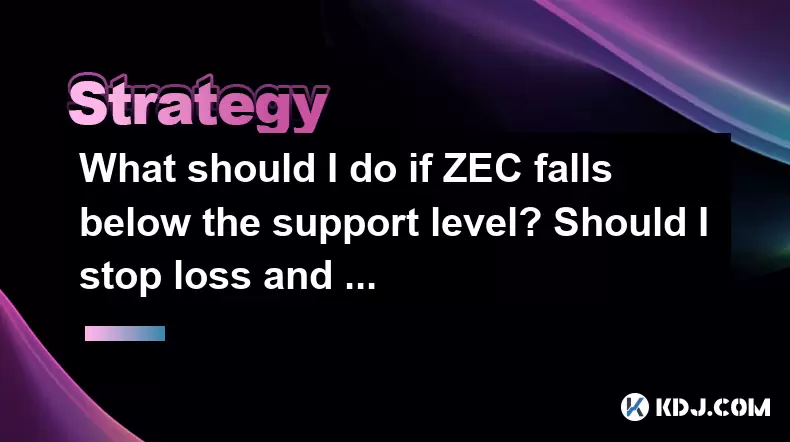-
 bitcoin
bitcoin $122659.385674 USD
0.52% -
 ethereum
ethereum $4484.113342 USD
-0.09% -
 bnb
bnb $1304.229256 USD
-0.85% -
 tether
tether $1.000204 USD
-0.03% -
 xrp
xrp $2.860636 USD
-0.51% -
 solana
solana $227.288799 USD
2.36% -
 usd-coin
usd-coin $0.999805 USD
0.01% -
 dogecoin
dogecoin $0.252837 USD
1.18% -
 tron
tron $0.341149 USD
1.12% -
 cardano
cardano $0.830507 USD
0.33% -
 hyperliquid
hyperliquid $45.792319 USD
0.04% -
 chainlink
chainlink $22.422164 USD
1.55% -
 ethena-usde
ethena-usde $1.000283 USD
0.01% -
 sui
sui $3.511389 USD
0.83% -
 stellar
stellar $0.385276 USD
-0.44%
What should I do if ZEC falls below the support level? Should I stop loss and wait and see or reverse operation?
If ZEC falls below support, decide between a stop loss for risk management, waiting for potential recovery, or reversing your position based on market analysis and risk tolerance.
May 09, 2025 at 03:00 am

If ZEC (Zcash) falls below its support level, you face a critical decision point in your trading strategy. The choice between implementing a stop loss and waiting to see what happens, or reversing your operation, depends on various factors including your risk tolerance, investment horizon, and market analysis. This article will explore these options in detail to help you make an informed decision.
Understanding Support Levels in ZEC Trading
Support levels are price points at which a cryptocurrency tends to find buying interest sufficient to halt a downward trend. When ZEC falls below a support level, it indicates that the selling pressure has overcome the buying interest, potentially signaling a further decline. It's crucial to understand that support levels are not absolute; they can be breached, leading to new market dynamics.
In the context of ZEC, if the price drops below a significant support level, traders need to reassess their positions. The first step is to evaluate the strength of the support level that was breached. Was it a minor support, or was it a critical threshold that many traders were watching? The answer to this question will influence your subsequent actions.
Option 1: Implementing a Stop Loss
A stop loss is an order placed with a broker to sell a security when it reaches a certain price. The primary purpose of a stop loss is to limit an investor's loss on a position. If ZEC falls below the support level, setting a stop loss can help you manage risk effectively.
- Determine the Stop Loss Level: Before ZEC reaches the support level, decide on a stop loss price. This could be just below the support level or at a level where you believe the price drop would be too significant to hold onto the position.
- Execute the Stop Loss: Once ZEC falls below the support level, your stop loss order will be triggered, and your position will be sold at the specified price or the next available price.
- Monitor the Market: After the stop loss is executed, continue to monitor ZEC's price movement. If the price rebounds, you might consider re-entering the market at a later stage.
Implementing a stop loss is a conservative approach that prioritizes capital preservation over potential gains. It's particularly suitable for traders who are risk-averse or those who cannot afford significant losses.
Option 2: Waiting and Seeing
Waiting and seeing involves holding onto your ZEC position even after it falls below the support level. This strategy is based on the belief that the price might recover or that the breach of the support level is a temporary phenomenon.
- Assess the Market Context: Look at broader market trends and news that might affect ZEC. Is the entire cryptocurrency market experiencing a downturn, or is the drop specific to ZEC?
- Technical Analysis: Use technical indicators like moving averages, RSI, and MACD to gauge whether the price drop is part of a larger bearish trend or a short-term correction.
- Fundamental Analysis: Consider ZEC's fundamentals, such as its technology, adoption rate, and any upcoming developments that could influence its price.
Waiting and seeing requires patience and a higher risk tolerance. It's suitable for traders who believe in the long-term potential of ZEC and are willing to weather short-term volatility.
Option 3: Reversing the Operation
Reversing the operation means selling your ZEC position and potentially taking a short position if you believe the price will continue to fall. This strategy is more aggressive and can be profitable if executed correctly, but it also carries higher risk.
- Short Selling: If you decide to reverse your operation, you can short sell ZEC. This involves borrowing ZEC and selling it at the current market price, with the intention of buying it back at a lower price to return to the lender.
- Set a Target Price: Determine a target price at which you will close your short position. This could be based on technical analysis or a predetermined percentage drop from the current price.
- Risk Management: Set a stop loss for your short position to limit potential losses if the price unexpectedly rises.
Reversing the operation is suitable for traders who are confident in their analysis and are willing to take on higher risk for potentially higher rewards.
Evaluating Your Risk Tolerance and Investment Goals
Your decision on what to do when ZEC falls below the support level should align with your risk tolerance and investment goals. If you are a conservative investor focused on capital preservation, implementing a stop loss might be the best approach. If you are more aggressive and believe in the long-term potential of ZEC, waiting and seeing or even reversing the operation could be viable strategies.
- Risk Tolerance: Assess how much risk you are willing to take. If the potential loss from holding onto ZEC is too high for your comfort level, a stop loss is advisable.
- Investment Goals: Consider your investment horizon. Are you looking for short-term gains, or are you in it for the long haul? Your goals will influence whether you choose to wait and see or take more immediate action.
Technical Analysis Tools for Decision Making
Technical analysis can provide valuable insights when ZEC falls below the support level. Here are some tools you can use to make informed decisions:
- Moving Averages: Use moving averages to identify trends. If ZEC falls below a key moving average, it might confirm a bearish trend.
- Relative Strength Index (RSI): The RSI can help you determine if ZEC is overbought or oversold. An RSI below 30 might indicate that ZEC is oversold and due for a rebound.
- MACD (Moving Average Convergence Divergence): The MACD can signal potential trend reversals. A bearish crossover might confirm your decision to implement a stop loss or reverse your operation.
By combining these technical indicators, you can gain a clearer picture of ZEC's price movement and make more informed decisions.
Frequently Asked Questions
Q1: How can I identify a strong support level for ZEC?A strong support level for ZEC can be identified by looking at historical price data. Look for levels where the price has bounced back multiple times in the past. Additionally, volume analysis can help; higher trading volumes at a particular price level indicate stronger support.
Q2: What are the risks of waiting and seeing after ZEC falls below the support level?The primary risk of waiting and seeing is that the price of ZEC could continue to fall, leading to significant losses. If the breach of the support level is part of a larger bearish trend, holding onto your position could result in a prolonged period of depreciation.
Q3: Can I use a combination of stop loss and waiting and seeing strategies?Yes, you can use a combination of strategies. For example, you could set a stop loss at a certain level but choose to wait and see if the price rebounds before reaching that level. This approach allows you to manage risk while still giving the market time to recover.
Q4: How does the overall market sentiment affect my decision when ZEC falls below the support level?Overall market sentiment can significantly impact your decision. If the broader cryptocurrency market is experiencing a bearish trend, it might be safer to implement a stop loss or reverse your operation. Conversely, if the market sentiment is bullish, waiting and seeing might be more appropriate, as the price of ZEC could rebound quickly.
Disclaimer:info@kdj.com
The information provided is not trading advice. kdj.com does not assume any responsibility for any investments made based on the information provided in this article. Cryptocurrencies are highly volatile and it is highly recommended that you invest with caution after thorough research!
If you believe that the content used on this website infringes your copyright, please contact us immediately (info@kdj.com) and we will delete it promptly.
- BlockDAG, DOGE, HYPE Sponsorship: Crypto Trends Shaping 2025
- 2025-10-01 00:25:13
- Deutsche Börse and Circle: A StableCoin Adoption Powerhouse in Europe
- 2025-10-01 00:25:13
- BlockDAG's Presale Buzz: Is It the Crypto to Watch in October 2025?
- 2025-10-01 00:30:13
- Bitcoin, Crypto, and IQ: When Genius Meets Digital Gold?
- 2025-10-01 00:30:13
- Stablecoins, American Innovation, and Wallet Tokens: The Next Frontier
- 2025-10-01 00:35:12
- NBU, Coins, and Crypto in Ukraine: A New Yorker's Take
- 2025-10-01 00:45:14
Related knowledge

Practical parameter settings for a Bitcoin multi-timeframe moving average system
Sep 18,2025 at 10:54pm
Optimizing Timeframe Combinations for Bitcoin Trading1. Selecting appropriate timeframes is crucial when building a multi-timeframe moving average sys...

How can I filter out false breakouts in Dogecoin high-frequency trading?
Sep 22,2025 at 01:00am
Understanding False Breakouts in Dogecoin Trading1. A false breakout occurs when Dogecoin's price appears to move beyond a defined support or resistan...

Techniques for identifying tops and bottoms in the Bitcoin on-chain NVT model
Sep 20,2025 at 07:54pm
Understanding the NVT Model in Bitcoin Analysis1. The Network Value to Transactions (NVT) ratio is often described as the 'P/E ratio' of the cryptocur...

What does the surge in open interest in Bitcoincoin futures mean?
Sep 20,2025 at 11:18pm
Understanding the Surge in Dogecoin Futures Open Interest1. A surge in open interest within Dogecoin futures indicates a growing number of active cont...

How can I use the Ethereum USDT premium to gauge market sentiment?
Sep 18,2025 at 11:55pm
Understanding the Ethereum USDT Premium1. The Ethereum USDT premium refers to the price difference between USDT (Tether) traded on Ethereum-based plat...

What should I do if Ethereum staking yields decline?
Sep 20,2025 at 06:18am
Understanding the Causes Behind Declining Ethereum Staking Yields1. The Ethereum network transitioned to a proof-of-stake consensus mechanism with the...

Practical parameter settings for a Bitcoin multi-timeframe moving average system
Sep 18,2025 at 10:54pm
Optimizing Timeframe Combinations for Bitcoin Trading1. Selecting appropriate timeframes is crucial when building a multi-timeframe moving average sys...

How can I filter out false breakouts in Dogecoin high-frequency trading?
Sep 22,2025 at 01:00am
Understanding False Breakouts in Dogecoin Trading1. A false breakout occurs when Dogecoin's price appears to move beyond a defined support or resistan...

Techniques for identifying tops and bottoms in the Bitcoin on-chain NVT model
Sep 20,2025 at 07:54pm
Understanding the NVT Model in Bitcoin Analysis1. The Network Value to Transactions (NVT) ratio is often described as the 'P/E ratio' of the cryptocur...

What does the surge in open interest in Bitcoincoin futures mean?
Sep 20,2025 at 11:18pm
Understanding the Surge in Dogecoin Futures Open Interest1. A surge in open interest within Dogecoin futures indicates a growing number of active cont...

How can I use the Ethereum USDT premium to gauge market sentiment?
Sep 18,2025 at 11:55pm
Understanding the Ethereum USDT Premium1. The Ethereum USDT premium refers to the price difference between USDT (Tether) traded on Ethereum-based plat...

What should I do if Ethereum staking yields decline?
Sep 20,2025 at 06:18am
Understanding the Causes Behind Declining Ethereum Staking Yields1. The Ethereum network transitioned to a proof-of-stake consensus mechanism with the...
See all articles










































































